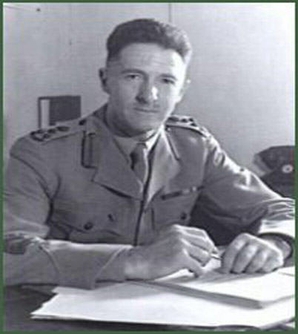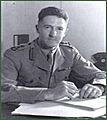Ian Ross Campbell facts for kids
Quick facts for kids
Ian Ross Campbell
|
|
|---|---|

Campbell in 1950
|
|
| Born | 23 March 1900 Moss Vale, New South Wales |
| Died | 31 October 1997 (aged 97) |
| Buried |
Bong Bong Presbyterian Cemetery, Moss Vale, New South Wales
|
| Allegiance | Australia |
| Service/ |
Australian Army |
| Years of service | 1922–1957 |
| Rank | Major General |
| Service number | VX21 |
| Commands held | 2/1st Battalion 34th Brigade |
| Battles/wars | Second World War Korean War |
| Awards | Commander of the Order of the British Empire Distinguished Service Order (2) Knight Commander of the Order of the Phoenix (Greece) |
| Spouse(s) |
Patience Russell
(m. 1927; died 1961)Irene Cardamatis
(m. 1967) |
Major General Ian Ross Campbell (born March 23, 1900 – died October 31, 1997) was a brave Australian soldier and a smart businessman. He served his country during two big wars: the Second World War and the Korean War. He was known for his courage and leadership.
Contents
Early Life and Army Training
Ian Ross Campbell was born in Moss Vale, New South Wales, Australia, on March 23, 1900. His father, Gerald Ross Campbell, was a lawyer and also a soldier. Ian went to school at Scots College, Sydney.
In 1919, Ian joined the Royal Military College, Duntroon, which is a special school for training army officers. He was a very good student. When he graduated in 1922, he won the Sword of Honour. This award is given to the best student in his class. After graduating, he became a second lieutenant, which is a starting rank for officers in the army.
Early Military Roles
After Duntroon, Ian worked in different army jobs. He was an adjutant and quartermaster for the 36th Battalion. This meant he helped manage the daily activities and supplies for the soldiers. He even spent some time in India, training with the British Army.
Ian loved adventure! He was a very keen mountain climber and even took part in climbs on Mount Everest, the world's highest mountain.
In 1927, he married Patience A. Russell. They had one daughter named Gillian. Ian continued to serve in the army, moving up in rank. By 1930, he was a captain. He also worked for the Governor of New South Wales, helping him with his duties. Later, he went to a special training school in England called the Staff College, Camberley. This school taught officers how to plan and lead large groups of soldiers.
Serving in the Second World War
When the Second World War began, Ian Campbell quickly joined the Second Australian Imperial Force (AIF) in 1939. He was given the service number VX21. He became a major in the 2/1st Battalion. Soon after, he became the brigade major for the 16th Brigade. This meant he was a key helper to the brigade's commander, making sure plans were carried out.
Heroism at Bardia
Ian showed great bravery during the Battle of Bardia in North Africa. He was awarded the Distinguished Service Order (DSO) for his actions. This award is given for outstanding leadership and courage in battle.
During the battle, he bravely scouted enemy areas, even under fire. His careful planning helped the Australian soldiers attack successfully. He was always on the front lines, giving instructions and inspiring his troops. His leadership helped the attack succeed.
Defending Crete
In 1941, Ian was given a temporary rank of lieutenant colonel and took command of the 2/1st Battalion. He was sent to the island of Crete. Here, he led Australian and Greek soldiers in defending the Retimo airfield from a large attack by German paratroopers.
For ten days, his troops fought bravely, often with limited supplies and using captured weapons. They managed to hold off the enemy, even shooting down several German planes. Ian's leadership kept his soldiers' spirits high. He even personally led an attack that helped his battalion win back an important area.
Eventually, the Germans brought in many more soldiers, tanks, and artillery. With their supplies gone, Ian's force had to surrender. He became a prisoner of war in Germany. For his amazing courage and leadership in Crete, he received a second bar to his Distinguished Service Order. He was also honored by Greece with the title of Knight Commander of the Order of the Phoenix.
Life as a Prisoner
Ian was a prisoner of war until he was freed in 1945. After his release, he helped manage a camp for other Australian prisoners who had been freed. He returned to Australia later that year.
Later Life and Career
After the war, Ian continued his career in the Australian Army. He held several important leadership positions. He became the Deputy Adjutant General of the Australian Military Forces, helping to manage the army's personnel. He also became the Director of Military Training, overseeing how soldiers were trained.
In 1949, he took command of the 34th Brigade, which later became the 1st Brigade. From 1951 to 1953, he was in charge of the Australian forces in Korea and Japan.
In 1953, Ian became the head of the Australian Army Staff College. The next year, he became the commandant of the Royal Military College, Duntroon, where he had trained as a young officer. He was promoted to the rank of Major General in 1954. He retired from the army in 1957.
After the Army
After leaving the army, Ian Campbell worked for a company called James Hardie Industries. He also dedicated his time to helping others. He served as the chairman of the New South Wales Red Cross, a charity that helps people in need. He also worked for other charities.
His first wife, Patience, passed away in 1961. He later married Irene Cardamatis in 1967.
Ian Ross Campbell died on October 31, 1997. He was buried in Moss Vale, his hometown. As a special tribute, the people of Crete, where he had fought so bravely, sent an urn of soil from their island to be buried with him.
Images for kids


